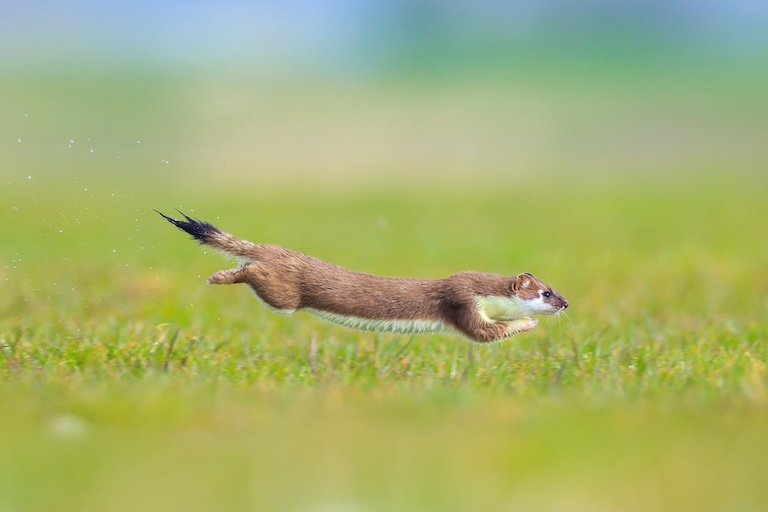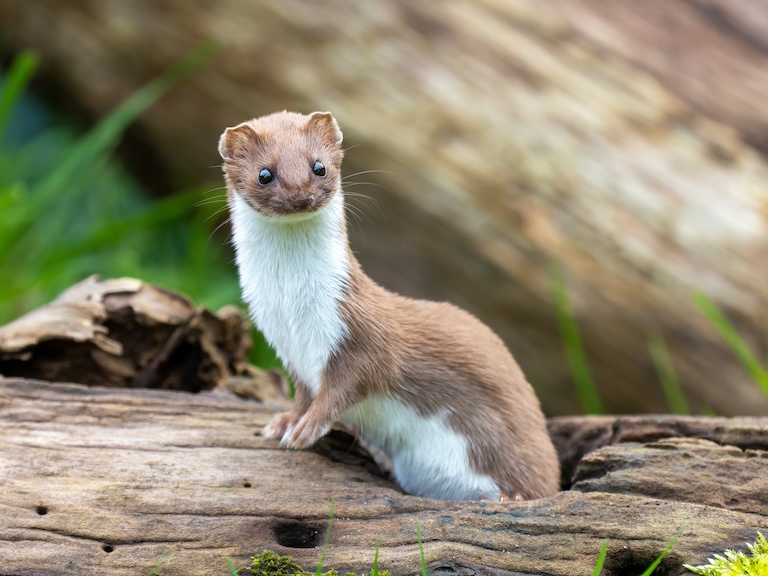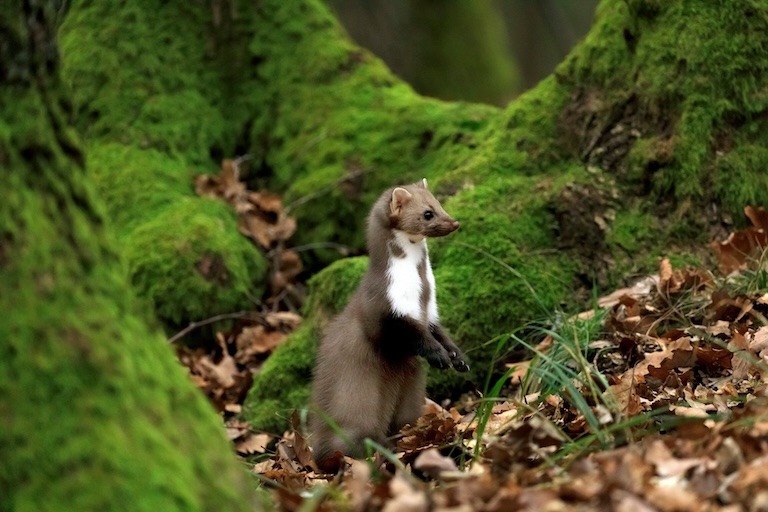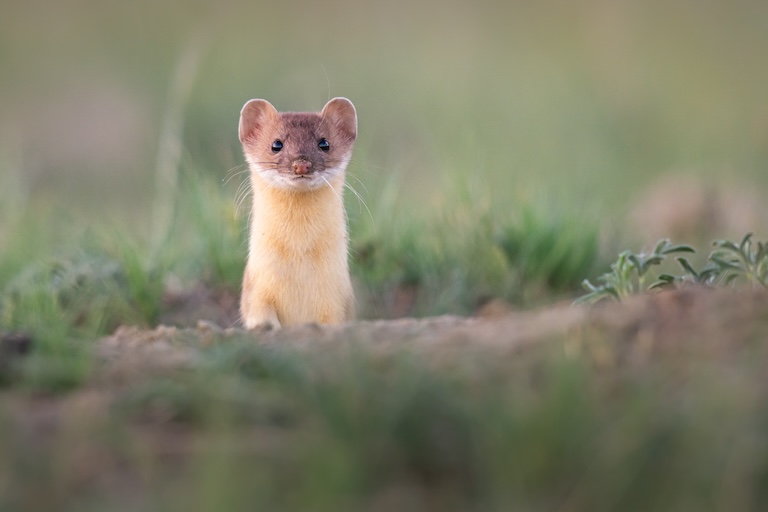Weasel Profile
There are several contenders for the “pound-for-pound” toughest mammals alive, and they’re probably not what you’d expect. Lions are oversized kittens, wolves are mostly just marathon runners with teeth, and even hyenas generally need the support of their clan to get anything meaningful done.
No, the toughest mammals on the planet are smaller than this, and so they generally go unnoticed. Mustelids are a family of carnivorans that is home to some of the most ferocious hunters on Earth.
Everyone’s familiar with the toughness of the honey badger. Well, guess what? Mustelid! But pound-for-pound, one of the toughest mammals on the planet has to be the weasel.

Weasel Facts Overview
| Habitat: | Terrestrial: all of them |
| Location: | Mostly Eurasia, North America, some in South America, Africa, Southeast Asia |
| Lifespan: | Up to 14 years in larger species |
| Size: | 20cm (8 inches) to around 50cm (20 inches) |
| Weight: | Up to 1.7 kg (14 oz) |
| Colour: | White to black, with variations of browns and creams in between |
| Diet: | Mostly carnivorous, mammals, birds, eggs, reptiles, amphibians, but also fruits and seeds |
| Predators: | Foxes, sables, polecats, raptors, some snakes |
| Top Speed: | Possibly around 24 km/h (15 mph) |
| No. of Species: | 8 – 19 |
| Conservation Status: | From Least Concern to Critically Endangered (IUCN) |
Weasels, like domestic cats, have this eerie combination of adorableness and murderous intent. Yet, unlike cats, they’ll run headlong into a brawl with their dinner, sometimes tackling an animal ten times their mass.
These intelligent, solitary hunters are ridiculously successful animals, spanning much of the globe and dominating almost every terrestrial habitat in the Northern Hemisphere and beyond.
They’ve got a long history with humans, but despite this, they’re often considered pests or otherwise unpleasant.
But the truth is, people who think weasels suck are, themselves, deeply sad and unpleasant people, and they should feel bad about themselves because the peer-reviewed literature has repeatedly shown that weasels are some of the best animals in the world.
Interesting Weasel Facts
1. They’re the most mustelid
It doesn’t get more mustelid than a weasel. They’re members of the Mustelidae family, like the badgers and skunks, but they’re separated from those larger animals at the subfamily level, in which they occupy Mustelinae with the equally badass ferrets and minks.
The distinction goes one level deeper, to the genus Mustela, where the true weasels sit. They are the archetypal mustelid, and well deserving of the title.
There are some animals in North America that are called weasels, but they’re from the sister genus Neogale.
Within the true weasel genus, though, are many weasel-like animals such as the polecats, ferrets and ermine, and there are linguistic habits in different groups that determine whether the word refers to the entire genus, or just the smallest species of the lot, the least weasel. 1

2. They’re the least weasel
Perhaps the most ironically named animal since the penduline tit, the least weasel is, contrastingly, the most – and in some circles the only – weasel.
The Least weasel is actually named because its head is small enough to fit through a wedding ring. It’s the smallest Mustela species, yet it has one of the widest ranges.
It spans all across Eurasia and North America, touching into North Africa and the far East of Asia. inhabiting grasslands, shrublands, wetlands, forests and rocky areas. It’s comfortable on the coast or inland and even inhabits artificial or otherwise developed landscapes.
It’s also been introduced to places that didn’t really want it, like New Zealand and the Azores.
This tiny mustelid commonly grows to no more than 20cm long, yet it carries the fire of a thousand suns behind that cute little face. While they mainly eat rodents, they’re not beyond taking down a rabbit or even a hare, which they attack with a powerful bite to the brain case.
3. They’re formidable
Even the least weasel is a powerful predator. Weasels are said to be able to tackle animals up to ten times their size. And unlike pack animals like lions and wolves, they accomplish this alone.
Even a tiny weasel needs to eat quite a lot in a day, and will mostly get what they need from the local rodent population but they are also able to chase down, tire, and kill a rabbit when the chance presents itself.
This is the equivalent of the largest male lion bringing down two of the largest white rhinos by himself. Weasels kill with a piercing bite to the skull or spine, just like a jaguar, and are able to quickly dispatch surprisingly large animals. 2 3
4. Their smells are recognisable
An animal this tough no doubt has a reputation in the community. And animals know when they smell a weasel.
In lab tests, hamsters get extremely upset if you smear the anal secretions from a weasel on them, and not just because it’s a very disrespectful thing to do to someone.
Weasel scent is well recognised in rodents, and this may be an innate response: an instinct that tells the animal they’re not safe when there’s a tiny top predator about. 4

5. They can live anywhere
These animals are highly adaptable to all kinds of ecosystems. From tropical rainforests to tundra and from steppe and desert to riparian biotopes and coastal waters, weasels have found and occupied niches all over the Northern Hemisphere.
The Mountain weasel lives in high-altitude environments around Tibet and the Himalayas. The missing-toothed pygmy weasel also prefers the mountains, inhabiting the rocky terrain of the Sichuan province in China.
Others, like the mink, are semi-aquatic and can be very comfortable on coasts and in streams. Even the jungles of Borneo have a species of weasel living in them. These are some of the most successful little mammals left on Earth. 5

6. They’ve been domesticated
The common ferret is a species of weasel. These tough and intelligent animals are popular pets and are one of the larger species in the Mustela genus.
They have been domesticated for thousands of years, perhaps having once been bred as rabbit hunters or sport fighters.
7. They’ve been disrespected
Yet, with this long and impressive history alongside humans, our language is riddled with disrespectful terms and superstitions around weasels.
In Greek culture, having one around brings bad luck. As too, was the opinion of 17th Century Brits. In English, a weasel is a sly and cowardly person, inherently untrustworthy.
In the 15th Century in Germany, weasel amulets were said to have powerful magic and the animals were killed ritualistically, and in Japan, hearing a weasel was a bad omen.
It seems that only Macedonians had it right: They historically saw the good in these animals, and their presence was said to bring good luck.
Weasel Fact-File Summary
Scientific Classification
| Kingdom: | Animalia |
| Phylum: | Chordata |
| Class: | Mammalia |
| Order: | Carnivora |
| Family: | Mustelidae |
| Genus: | Mustela |
Fact Sources & References
- “Least Weasel”, IUCN Red List.
- Sarah Moore (2021), “Weasels are small but serious predators capable of eating 35% of their body weight each day”, CBC News.
- BBC (2004), “Stoat kills rabbit ten times its size – Life”, YouTube.
- Jian-Xu Zhang (2003), “Effects of weasel odor on behavior and physiology of two hamster species”, National Library of Medicine.
- Yingxun Liu (2023), “Revalidation and expanded description of Mustela aistoodonnivalis (Mustelidae: Carnivora) based on a multigene phylogeny and morphology”, Wiley Online Library.
